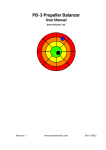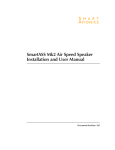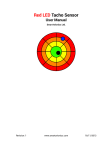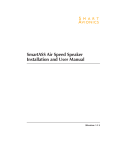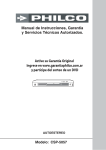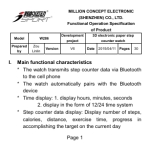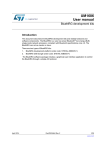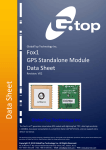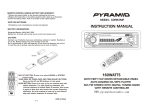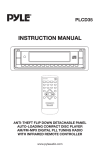Download SmartASS-3 Air Speed Speaker Installation and User Manual
Transcript
SmartASS-3 Air Speed Speaker Installation and User Manual Smart Avionics Ltd. GND CANL CANH GND PANEL UC IO-1 IO-2 AUDIO PITOT +12V SmartASS-3 STATIC WWW.SMARTAVIONICS.COM Revision: 1 www.smartavionics.com 24/07/2014 SmartASS-3 Air Speed Speaker Installation and User Manual Copyright © 2006-2014 Smart Avionics Ltd. Table of Contents 1. Introduction ................................................................................................. 1 1.1. Why speak speed? ............................................................................ 1 1.2. Overview of installation .................................................................... 2 1.3. Specifications ................................................................................... 4 1.4. Installing software updates ............................................................. 4 2. Installing the SmartASS-3 .......................................................................... 5 2.1. Setting the configuration switches .................................................. 5 2.1.1. Configuring the speed units .................................................. 6 2.1.2. Configuring the undercarriage alert ...................................... 6 2.1.3. Configuring the general alert ................................................. 6 2.1.4. Firmware upgrade switch ...................................................... 7 2.2. Mounting the enclosure ................................................................... 7 2.3. Mounting the control knob ............................................................... 7 2.4. Pitot and static connections ............................................................ 7 2.5. Electrical connections ...................................................................... 8 2.5.1. Audio connections ................................................................. 8 2.5.2. Alert connections ................................................................... 9 2.5.3. CAN bus connections ............................................................ 9 2.6. Installation approval ......................................................................... 9 3. Using the SmartASS-3 .............................................................................. 11 3.1. The operating modes ..................................................................... 11 3.1.1. Talking ASI mode ................................................................. 11 3.1.2. Speed director mode ........................................................... 11 3.1.3. Sleep mode .......................................................................... 12 3.2. The controls .................................................................................... 12 3.2.1. Push switch primary functions ........................................... 13 3.2.2. Push switch secondary functions ...................................... 14 3.2.3. Push switch summary ......................................................... 15 3.3. Zeroing the SmartASS-3 ................................................................ 15 3.4. Self Test Failure .............................................................................. 16 A. Hacking the SmartASS-3 ......................................................................... 17 A.1. SmartASS-3 Lua files ..................................................................... 17 A.2. Building and flashing eLua ............................................................ 18 B. eLua Open Source License ....................................................................... 19 Index .............................................................................................................. 21 www.smartavionics.com iii iv www.smartavionics.com List of Figures 1.1. SmartASS-3 Enclosure Panel .................................................................. 2 1.2. Enclosure .................................................................................................. 3 1.3. Control Knob ............................................................................................ 3 1.4. Control Knob Label .................................................................................. 3 2.1. Configuration Switches ........................................................................... 6 www.smartavionics.com v vi www.smartavionics.com List of Tables 1.1. Specifications ........................................................................................... 4 2.1. Electrical connections ............................................................................. 8 3.1. Push switch functions ........................................................................... 15 www.smartavionics.com vii viii www.smartavionics.com Chapter 1. Introduction This manual describes how to install and use the Smart Avionics Air Speed Speaker Mk3 (hereafter referred to as the “SmartASS-3”). Please read it before installing and using the SmartASS-3. If you have any questions, please send email to [email protected] . 1.1. Why speak speed? The SmartASS-3 has been developed to provide the pilot of a homebuilt/experimental aircraft with a means of accurately determining their airspeed without having to look at the airspeed indicator. It does this by “speaking the speed” in either Knots, MPH or KPH through the intercom/radio system and hence into the pilot's headset. It can be used during any phase of flight but it has been specifically developed for use during the approach phase when both airspeed and flight path need to be accurately controlled. During the approach to a short field or if the conditions are challenging, both speed and flight path are critical. The SmartASS-3 is helpful because: 1. It reduces the amount of time the pilot has to be looking inside the cockpit so more attention can be paid to getting the flight path right. 2. It supplies the pilot with airspeed information in a form that is easier to assimilate than by looking at an ASI. 3. It can warn the pilot when the speed has deviated significantly from a nominated “target speed”. This last capability (referred to as “speed director mode”) really sets the SmartASS-3 apart from a conventional ASI. In speed director mode, instead of simply reporting the current airspeed, the SmartASS-3 will actively monitor the airspeed, compare it to the target airspeed and then report deviations from the target speed. The more the airspeed deviates from the target speed, the more the SmartASS-3 will talk. Using the SmartASS-3, once the aircraft has been configured for final approach and the checks have been carried out, the pilot can concentrate on eyeballing the approach and no longer has to look at the ASI to check the airspeed every few seconds. The SmartASS-3 also features: • A 3-axis accelerometer for measuring the acceleration in the vertical direction so that the wing loading can be determined – by taking the wing www.smartavionics.com 1 Overview of installation loading into account, the speed director becomes a “stall margin preserver” i.e. it assists the pilot in maintaining a safe speed margin above the stall. • An optional audible undercarriage alert that will be triggered when the speed reduces to the approach speed but the undercarriage is not down and locked. • An optional audible general alert that can be triggered by any external system. Important Although the SmartASS-3 is accurate and reliable it is intended that it is used in conjunction with the existing ASI instrument(s) rather than replacing them. Important The SmartASS-3 is not a stall warning system and it does not provide a stall warning function. 1.2. Overview of installation Chapter 2 covers the installation of the SmartASS-3 in detail, here we just give an overview. The SmartASS-3 electronics are contained in a lightweight aluminium enclosure (Fig 1.2) that may be mounted in any convenient position and orientation. The enclosure is equipped with two barbed air connectors for plumbing the unit into the aircraft's pitot and static lines. PITOT MICRO USB SD 10 WAY CONNECTOR CARD 1 10 STATIC Fig 1.1. SmartASS-3 Enclosure Panel The SmartASS-3's electrical connections are via a removable 10 way screw terminal connector. A micro SD memory card holds the audio files and some 1 other configuration data . A combined volume control + push switch (Fig 1.3) that selects the mode of operation is mounted in any suitable location such that it can be easily accessed while flying. 1 The micro USB socket is used by Smart Avionics when the unit is being tested and calibrated. 2 www.smartavionics.com Overview of installation Fig 1.2. Enclosure Fig 1.3. Control Knob SmartASS-3 Turn Knob To Adjust Volume Push Knob To Change Mode Fig 1.4. Control Knob Label www.smartavionics.com 3 Specifications 1.3. Specifications All temperature specifications refer to the temperature of the SmartASS-3 enclosure, not the outside air temperature. Table 1.1. Specifications Operating Temperature Range -25°C - 85°C Minimum Speed 25 Knots / 30 MPH / 50 KPH Silent below this speed Maximum Speed 250 Knots / 287 MPH / 462 KPH Not an absolute limit Absolute ±2% Accuracy (linearity & offset) In the temperature range 0°C - 85°C. Assumes unit has been recently zeroed Repeatability (pressure hysteresis) ±0.1% At 25°C. For speeds between 25 and 250 Knots Supply Voltage 6-18V Reverse polarity protected Supply Current 100 mA Audio Output Voltage 3V Peak Minimum Load Impedance 50 Ohms Electrical Connector 10 Way plug/socket Screw terminals Air Connectors Hose barbs Requires 4mm ID tubing Enclosure Dimensions 140 x 86 x 30 mm Includes mounting tabs Total Weight 230 grams With 200 Ohm load 1.4. Installing software updates Software updates are installed simply by copying the updated file(s) into the top-level (root) directory of the SD card. This can be done on any system (Linux, Mac, Windows, etc.) that supports SD card storage (either directly or via a USB adapter). Please ensure the power is off before ejecting or inserting the SD card and that the card is fully home before applying power again. 4 www.smartavionics.com Chapter 2. Installing the SmartASS-3 Installation of the SmartASS-3 consists of the following steps: 1. Setting the configuration switches (if necessary). 2. Mounting the enclosure within the instrument panel. 3. Mounting the control knob on the instrument panel. 4. Connecting the pitot and static connections. 5. Connecting the power supply and audio output wires and, optionally, the undercarriage and general alert wires. 6. Carry out a one-time initialisation procedure that orientates the accelerometer (described in Section 3.2.2.2). 2.1. Setting the configuration switches If you wish to change the speed units from the default setting of Knots or enable the undercarriage or general alert functions, you will need to access the configuration switches on the circuit board. To gain access to the board, remove the 10 way connector and the SD card, and then remove the four screws and the front plate and slide the board out. Four switches are located together in one block on the left side of the PCB. One other switch is located about 3cm away (4 o'clock position) from the block of 4. All the switches have yellow tops and a small arrow that shows the direction the switch must be moved to turn it on. Use the end of a small screwdriver or pencil to move the switch and make sure that the other switches are not moved also (it's rather easy to do that). Fig 2.1 shows the layout of the switches in their default positions (all off). After the switches have been configured, slide the PCB back into the case and replace the front plate and screws. Reinsert the SD card and 10 way connector. Important The circuit board contains components that may be damaged by static electricity. Try to avoid touching the components on the board and, if possible, remove any static charge that you may be carrying by touching something that is earthed before handling the unit. www.smartavionics.com 5 GA UCA KPH MPH ON ON ON ON Configuring the speed units FIRMWARE UPGRADE (OFF) ON Fig 2.1. Configuration Switches 2.1.1. Configuring the speed units By default, the SmartASS-3 reports the airspeed in Knots. If desired, the airspeed can be reported in either MPH or KPH by closing the appropriate switch. Slide the switch to the on position to select the required speed unit. 2.1.2. Configuring the undercarriage alert If you want to use the undercarriage alert feature, move the UCA switch to the on position. If you have a retractable undercarriage, you can enable this alert even if you don't have a switch that signals when the undercarriage is down and locked. In that case, whenever speed director mode is entered, the undercarriage alert will be triggered to remind you to check that the wheels are down. Once the alert has sounded, briefly press the push switch to cancel the alert. If you do have the undercarriage down switch, the alert will be suppressed if the undercarriage is down when speed director mode is entered. 2.1.3. Configuring the general alert If you want to use the general alert feature, move the GA switch to the on position. When enabled, the general alert will be triggered by a low level on the general alert input (IO-1). Once the alert has sounded, briefly press the push switch to cancel the alert. 6 www.smartavionics.com Firmware upgrade switch 2.1.4. Firmware upgrade switch This switch is turned on to enable the firmware to be upgraded via the micro USB connector. In normal operation, this switch must be off. 2.2. Mounting the enclosure The enclosure can be mounted in any convenient position and orientation within the instrument panel area. If possible, mount close to the centreline of the aircraft to minimise the effect of roll on the accelerometer readings (this isn't absolutely essential). Remember to leave adequate space so that the pitot and static lines are not kinked. Although the SmartASS-3 is robust, avoid subjecting it to excessive vibration or extremes of temperature. Important Take care to ensure that the SD card is fully home in its socket as it is quite easy to “eject” the card by mistake. 2.3. Mounting the control knob The control knob should be mounted in a position such that it can easily be operated while flying. The hole required is 10.2mm diameter with 8.3mm flats to stop the potentiometer body from turning. The potentiometer manufacturer's recommended torque for tightening the retaining nut is 45cN.m If the wires from the control knob to the enclosure are too long, they may either be shortened or coiled up. 2.4. Pitot and static connections The SmartASS-3's pressure sensor has barbed connections suitable for 4 mm ID hose. Exactly how the pitot and static connections are plumbed into the aircraft's pitot and static lines will be different for each aircraft but, generally speaking, tee connectors can be inserted into the existing lines so that the SmartASS-3 is connected in parallel with the existing ASI. Take care to ensure that all the connections are sound and that no leaks are present. Important Once the installation is completed, carry out a leak test on the pitot and static lines to ensure that no leaks have been introduced. www.smartavionics.com 7 Electrical connections 2.5. Electrical connections All the electrical connections are made through the 10 way connector. Make sure that the wires are securely held in the connector terminals. Use cable-ties or lacing cord to bundle the wires near the connector. This will reduce the chance of the wires coming loose in the connector or fracturing due to flexing. Table 2.1. Electrical connections Terminal Name Connection 1 GND Radio/intercom ground 2 CANL CAN bus low 3 CANH CAN bus high 4 GND Control knob (either connection) 5 PANEL Control knob (either connection) 6 UC Switch to ground when U/C down and locked 7 IO-1 Input/Output #1 - switch to ground to signal general alert 8 IO-2 Input/Output #2 9 AUDIO Audio output to radio/intercom input 10 +12V Fused 12V supply 2.5.1. Audio connections For audio output, these wires need to be connected: 8 GND (terminal 1) This is connected to the main ground bus-bar or a ground associated with the radio or intercom. GND & PANEL (4 & 5) These connections are to the two wires from the control knob. AUDIO (terminal 9) This is connected to an auxiliary or music input of the aircraft's existing radio/intercom/audio panel installation. Exactly where this should be connected obviously depends on the specific equipment being connected to. +12V (terminal 10) This is connected to +12V via a fuse or circuit breaker. The current requirement of the SmartASS-3 is small so the fuse rating need not be more than 1A. The SmartASS-3 does not have an on/off switch as it doesn't really need one but, if you wish, you could put a switch into this line. www.smartavionics.com Alert connections Note Intercoms and radios often have the ability to mute the auxiliary input when radio transmissions are being received. It is up to you to decide whether to mute the output from the SmartASS-3 or not. Note If the volume of the SmartASS-3's output is not well matched to the sensitivity of the existing equipment's input and that equipment has no means of adjusting its sensitivity, please contact Smart Avionics for advice. 2.5.2. Alert connections If you wish to use the audio alerts, two more wires can be connected: UC (terminal 6) If you want to use the undercarriage warning facility, install a switch that connects this terminal to ground when the undercarriage is down and locked. When the undercarriage alert is activated, you will hear: “DING! Check wheels down, ...”. Pressing the push switch briefly or putting the undercarriage down will silence the alert. Remember to enable this feature by setting the appropriate configuration switch as described on Section 2.1.2. IO-1 (terminal 7) Switching this terminal to ground will trigger the general audible alert. When the general alert is activated, you will hear: “DING! Alert, ...”. Pressing the push switch briefly will silence the alert. Remember to enable this feature by setting the appropriate configuration switch as described on Section 2.1.3. 2.5.3. CAN bus connections The SmartASS-3 transmits airspeed and acceleration (vertical G) data on the CAN bus (terminals 2 and 3). The data rate is 250K bits/S and the messages are in CAN Aerospace format. Please contact Smart Avionics for more details if you wish to make use of this data. 2.6. Installation approval Before the aircraft can be flown with the SmartASS-3 installed, the installation has to be approved. Exactly how this is achieved differs from country to country. www.smartavionics.com 9 Installation approval In the UK, the installation must be inspected and approved by your LAA inspector and an entry made in the airframe log book. The LAA will need to be informed that the SmartASS-3 has been fitted. 10 www.smartavionics.com Chapter 3. Using the SmartASS-3 3.1. The operating modes The SmartASS has three modes of operation: “talking ASI”, “speed director” and “sleep”. 3.1.1. Talking ASI mode This mode simply speaks the current airspeed every few seconds. The repeat period can be 3, 6 or 12 seconds. Also, if the speed changes very rapidly, the new speed is spoken straight away. When the speed is less than 25 Knots (30 MPH, 50 KPH) the voice is muted. When the SmartASS-3 is powered up, it always starts in talking ASI mode. 3.1.2. Speed director mode In this mode, the airspeed is continuously measured and compared to a target speed. The SmartASS-3 reports as follows: • If the speed is within 5% of the target speed, it says “Speed good” every 8 seconds • If the speed is between 5% and 10% too fast, it says “Fast” every 4 seconds. • If the speed is between 5% and 10% too slow, it says “Slow” every 4 seconds. • If the speed is between 10% and 15% too fast, it says “Very fast” every 2 seconds. • If the speed is between 10% and 15% too slow, it says “Very slow” every 2 seconds. • If the speed is more than 15% too slow or too fast, the appropriate message is prefixed with a chime. As the wing loading increases, the SmartASS-3 estimates how much this will increase the stall speed and it subtracts that amount from the current airspeed. If the pilot “pulls G”, the SmartASS-3 will immediately report that the aircraft is slow even though the actual airspeed has not (yet) changed. Unloading the wing will immediately make the SmartASS-3 report a speed 1 increase . 1 The SmartASS-3 ignores reduced G (less than +1) so it will not be fooled into telling you that you are fast if you move the stick forward rapidly. www.smartavionics.com 11 Sleep mode If the speed drops to below 80% of the target speed or is above 125% of the target speed, the SmartASS-3 reverts to talking ASI mode. Speed director mode is entered automatically when the speed falls to within 5% of the target speed. In speed director mode, the volume of the voice will automatically reduce the longer you stay within a given speed band. So if the air is smooth and you are flying accurately, the “Speed good” messages will become quieter and quieter as you progress towards the runway threshold. If the speed strays into another speed band, the volume immediately increases back to the original level. Tip • Always trim the aircraft accurately for the chosen approach speed. • Try not to “chase” the airspeed, especially when the air is rough. • Aim to smoothly increase or decrease the speed to keep the “speed good”. • The airspeed cannot change instantly, it takes a few moments for a change in attitude or power to have an effect on the airspeed and a bit longer for the SmartASS-3 (and your mechanical ASI) to measure that speed. 3.1.3. Sleep mode In this mode, the SmartASS-3 doesn't say anything at all. It doesn't even snore! Sleep mode continues until: • The pilot briefly presses the push switch to enable talking ASI mode. Typically, this could occur downwind in the circuit as the pilot prepares for the approach and landing. • The airspeed reduces to within 5% of the target speed and the SmartASS-3 automatically wakes up in speed director mode. • The general alert is triggered. 3.2. The controls The SmartASS-3 has been designed to be very easy to use. A combined volume control and push switch is all that is required. 12 www.smartavionics.com Push switch primary functions The volume control works in the conventional manner: turning the volume control clockwise increases the volume of the speech. Turning the volume control anti-clockwise reduces the volume. 2 When power is applied to the SmartASS-3, it says “Airspeed in Knots” and then, if the unit auto-zeroes itself, it will say “Airspeed zeroed”. Section 3.3 has more information about zeroing. If the unit has not yet been orientated, it will also say “G disabled”. Section 3.2.2.2 describes how the unit is orientated. Important If when the SmartASS-3 is switched on, the airspeed is at least 25 Knots (30 MPH, 50 KPH), the voice will say “Compare to ASI” after the speed is first reported. This is to remind the pilot to check that the spoken speed is consistent with the speed indicated on the ASI. If the speeds tally, the SmartASS-3 can be considered trustworthy. If there is a significant difference between the spoken speed and the speed shown on the ASI, the SmartASS should not be used until the discrepancy has been investigated. 3.2.1. Push switch primary functions The push switch has three primary functions: 3.2.1.1. Silencing an alert message If either of the undercarriage or general alerts sound, they can be silenced by 3 pressing the push switch briefly . 3.2.1.2. Selecting the operating mode Pressing the push switch briefly, toggles the mode of operation between talking ASI mode and either speed director or sleep modes. When in talking ASI mode, if the airspeed is no more than 125% of the target speed, pressing the push switch briefly will change to speed director mode. Otherwise, sleep mode is entered. Irrespective of the current airspeed, pressing the push switch briefly twice in quick succession will always enter sleep mode. Pressing the push switch briefly when in either speed director or sleep modes will change to talking ASI mode. The mode change is announced as follows: Talking ASI mode is selected The SmartASS-3 says “Airspeed” and then starts to speak the airspeed. 2 Or MPH or KPH depending on the units selected during installation. When you press the push switch briefly, you don't hear any audio feedback (no beep). 3 www.smartavionics.com 13 Push switch secondary functions Speed director mode is selected The SmartASS-3 announces the (previously captured) target airspeed by saying “Target speed is ...”. Listen to the number it says and confirm that is the speed you want. If the number it says is not what you want, you will need to capture a new airspeed as described below. Sleep mode is selected The SmartASS-3 says “Goodbye” and then goes silent. Note Until an airspeed has been captured, the SmartASS-3 will not select speed director mode. 3.2.1.3. Capturing the target airspeed Pressing the push switch for more than 1/2 second “captures” the current airspeed and switches to speed director mode if that mode is not already active. An audio “beep” sounds after the switch has been pressed for enough time to capture the airspeed. The new target airspeed will be announced as “Target speed is ...” and will be stored until another speed is captured. The target airspeed is remembered when the power is off. 3.2.2. Push switch secondary functions The push switch also has these secondary functions: 3.2.2.1. Selecting the airspeed repeat rate By default, the airspeed is repeated every 6 seconds in talking ASI mode. This period can be altered by pressing and holding the push switch until two beeps are heard. This will cycle the airspeed repeat period between the values of 3, 6 and 12 seconds. When the switch is released, you should hear the message “Repeat period is ...”. The selected value is remembered when the power is off. 3.2.2.2. Orientating the accelerometer Once the SmartASS-3 has been installed, the unit must be orientated so that it knows which way is up. With the aircraft positioned in the flying attitude, press and hold the push switch until three beeps are heard. When the switch is released you should hear the message “Orientation set”. The orientation is remembered when the power is off and this operation only needs to be repeated if the SmartASS-3 is re-positioned. 14 www.smartavionics.com Push switch summary This orientation operation can be carried out in flight – just take care to ensure that the aircraft is flying straight and level and that you are not subject to any vertical accelerations at the time. 3.2.2.3. Zeroing the pressure sensor Press and hold the push switch until you have heard the fourth beep. When the switch is released, the SmartASS-3 will say “Airspeed zeroed”. 3.2.3. Push switch summary This table summarises the operation of the push switch: Table 3.1. Push switch functions Action Effect 1 short press Silence alert 1 short press Toggle between talking ASI and speed director or sleep modes 2 short presses Enter sleep mode Hold for 1 beep Capture current airspeed and enter speed director mode Hold for 2 beeps Cycle through airspeed repeat periods Hold for 3 beeps Orientate accelerometer Hold for 4 beeps Zero pressure sensor 3.3. Zeroing the SmartASS-3 To ensure the airspeed reported by the SmartASS-3 is as accurate as possible, the unit requires zeroing occasionally. This will remove any offset error 4 introduced as the pressure sensor and the electronic components age. Whenever the SmartASS-3 is turned on, as long as the current differential pressure is small, it will be zeroed automatically to remove the offset error. If the differential pressure is not small when the unit is turned on, this auto-zeroing will not occur and you will hear “DING! airspeed not zeroed”. It is possible to manually zero the SmartASS-3 at any time. There are two ways of achieving this: 1. Apply power to the unit while already pressing the push switch. When the voice says “Airspeed zeroed”, release the push switch. 4 Due to the fact that airspeed is proportional to the square root of the dynamic pressure, the effect of a small offset error in the pressure measurement is only really significant at very low airspeeds. It's still worth removing the error to get the best possible result. www.smartavionics.com 15 Self Test Failure 2. With the SmartASS-3 already turned on, press and hold the push switch until you have heard the 4th beep and then release the switch. The SmartASS-3 will then say “Airspeed zeroed”. Important To ensure that the reported speed is accurate, do not manually zero the SmartASS-3 if any of the following are true: • The aircraft is moving at more than walking pace. • The wind is blowing into the pitot and it is more than a very gentle breeze. • The pitot cover is in position. • The temperature of the SmartASS-3 unit is below 0°C or above 40°C. 3.4. Self Test Failure When the SmartASS-3 is turned on, it carries out a sequence of tests to check that it is functioning correctly. If any of the tests fail, the SmartASS-3 goes into a loop, continuously reporting the failure through the audio interface. The failure is reported as “DING! Fail number” where number is the error code for the particular test that has failed. However, if the voice data cannot be accessed, the failure message can't be played and so, instead, the error is 5 signalled by bursts of random noise . In either case, please switch off the SmartASS-3 and contact Smart Avionics to resolve the problem. 5 Sounds a bit like the radio when a very weak transmission is received. 16 www.smartavionics.com Appendix A. Hacking the SmartASS-3 Note You don't have to read this Appendix to install and use the standard SmartASS-3. It's here to give some guidance to people who want to modify the SmartASS-3's behaviour. The SmartASS-3 program is written in the Lua scripting language (see www.lua.org. Lua is a widely used interpreted language that has been around for more than 20 years. The implementation used here is the eLua (embedded Lua) system (see www.eluaproject.net). Appendix B shows the eLua license. The SmartASS-3 source code is freely available as a git repository and can be found at https://bitbucket.org/smartavionics/elua-smartass. The SmartASS-3 specific files all reside in the smartass-master branch (and associated development branch, smartass-dev). These branches are based on the master branch which is synced with the upstream eLua repository. You can access the eLua console by connecting the SmartASS-3 USB socket to a PC and running a terminal emulator program. On Linux systems (or similar), screen /dev/ttyACM0 115200 will connect you to the console and you can see debug output. For Windows systems, various terminal emulator programs exist. PuTTY is freely available and works OK. A.1. SmartASS-3 Lua files The smartass directory contains these Lua script files: ad7798.lua Driver for the AD7798 ADC used to measure the pitot pressure. autorun.lua Startup script that is run when the device is powered up. It loads the smartass module and starts executing it. lis3dh.lua Driver for the LIS3DH accelerometer. smartass.lua The smartass module, this is where it all happens! wav.lua A very simple module for playing WAV audio files. This only copes with uncompressed 8 or 16 bit PCM data. You do not need to build and flash eLua when just these script files are modified. So if you change them, simply copy the changed files into the root directory of the SmartASS's SD card and they will be used instead of the original files. If you subsequently remove your files from the SD card, the originals will be used again. Take care not to remove any of the other files on the SD card. www.smartavionics.com 17 Building and flashing eLua A.2. Building and flashing eLua Note SmartASS-3 development is done using Linux host computers. However, it should be possible to build and flash eLua using non-Linux hosts as all of the tools used are available for other systems. To rebuild the underlying eLua system you need to install an ARM cross compilation system that provides arm-none-eabi-gcc and its companions. You can obtain these from https://launchpad.net/gcc-arm-embedded. A Makefile is provided that defines targets to build the eLua system and flash (download) it to the board. The board supports two methods of flashing: SWD Using a SWD adapter such as a STLINK-V2 attached to PL3, utilities such as openocd can be used to flash and debug the program. The PL3 connections are: 1. +3V3 (pin 1 is nearest to the SD card) 2. SWCLK 3. GND 4. SWDIO While flashing the program, you can either power the board via the 10 way connector or through the USB connector (by connecting a USB cable to a PC or a USB power adapter). This method of programming is a little faster than the DFU method and also gives you the ability to debug the C code using gdb. DFU 18 Utilities such as dfu-util can flash the program via the USB cable. To do this, the switch PL4 needs to be in the on position before power is applied to the board. The USB cable will power the board while it is being flashed so you don't need the 10 way connector plugged in. Remember to move PL4 back to the off position after the download has finished. The advantage of this method is that you only need a USB cable and no programming adapter. www.smartavionics.com Appendix B. eLua Open Source License Copyright (c) 2007, 2008, 2009, 2010, 2011 Dado Sutter and Bogdan Marinescu eLua is Open Source and is freely distributed under the MIT licence. The Lua part of eLua is licensed under the Lua licensing terms, which you can find at http://www.lua.org/license.html. The XMODEM code is adapted from the FreeBSD at91 library, which was written by M. Warner Losh and is released under the BSD license. The "pack" module is adapted from the "lpack" module by Luiz Henrique de Figueiredo and it's placed in the public domain. The "bit" module is adapted from the "bitlib" library by Reuben Thomas, distributed under a MIT license. The "integer only lua" is based on the "Go Long Lua!" patch by John D. Ramsdell (from the Lua Power Patches page) and is placed in the public domain. The multiple memory allocator (dlmalloc) is written by Doug Lea and is placed on the public domain. The TCP/IP stack is adapted from uIP, written by Adam Dunkels and released under a BSD license. The FAT file sistem is based on FatFs, written by Elm Chan (http://elm-chan.org). A copy of the FatFs license can be found in the LICENSE.fatfs file. The RPC implementation is based on Russell Smith's Lua-RPC (http://q12.org/lua/index.html). A copy of the Lua-RPC license can be found in the LICENSE.luarpc file. Manufacturer provided CPU support libraries are licensed under their own terms, check src/platform/*platform-name* for details. linenoise (https://github.com/antirez/linenoise, eLua's readline replacement) is released under a BSD license. The rest of the eLua code is licensed under MIT, listed below: The MIT License Copyright (c) 2007, 2008, 2009, 2010 Dado Sutter and Bogdan Marinescu www.smartavionics.com 19 Permission is hereby granted, free of charge, to any person obtaining a copy of this software and associated documentation files (the "Software"), to deal in the Software without restriction, including without limitation the rights to use, copy, modify, merge, publish, distribute, sublicense, and/or sell copies of the Software, and to permit persons to whom the Software is furnished to do so, subject to the following conditions: The above copyright notice and this permission notice shall be included in all copies or substantial portions of the Software. THE SOFTWARE IS PROVIDED "AS IS", WITHOUT WARRANTY OF ANY KIND, EXPRESS OR IMPLIED, INCLUDING BUT NOT LIMITED TO THE WARRANTIES OF MERCHANTABILITY, FITNESS FOR A PARTICULAR PURPOSE AND NONINFRINGEMENT. IN NO EVENT SHALL THE AUTHORS OR COPYRIGHT HOLDERS BE LIABLE FOR ANY CLAIM, DAMAGES OR OTHER LIABILITY, WHETHER IN AN ACTION OF CONTRACT, TORT OR OTHERWISE, ARISING FROM, OUT OF OR IN CONNECTION WITH THE SOFTWARE OR THE USE OR OTHER DEALINGS IN THE SOFTWARE. 20 www.smartavionics.com Index KPH, 6 M A accelerometer orientation, 14 airspeed capturing, 14 repeat rate, 14 alert, 9 general, 6 undercarriage, 6 C CAN bus, 9 capturing airspeed, 14 check wheels down, 9 configuring general alert, 6 speed units, 6 undercarriage alert, 6 connections electrical, 8 pitot and static, 7 control knob mounting, 7 E electrical connections, 8 enclosure mounting, 7 modes of operation, 11 MPH, 6 mute audio input, 9 O operating modes, 11 orientation, 14 P pitot connection, 7 push switch, 12-13 S SD card, 2 self test failure, 16 software updates installing, 4 specifications, 4 speed director mode, 1, 11 static connection, 7 static electricity warning, 5 switch configuration, 5 T talking ASI mode, 11 U F Fail message, 16 firmware upgrade switch, 7 G G disabled, 13 general alert wiring, 9 undercarriage warning wiring, 9 V volume control, 12 Z zeroing, 15 I installation approval, 9 K Knots, 6 www.smartavionics.com 21 22 www.smartavionics.com































